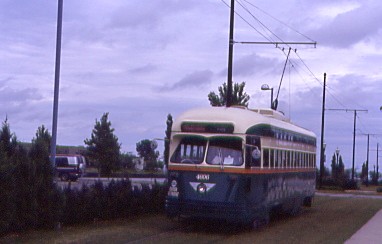
As I exited the Kenosha Metra station, the arrangemens I made with Lew Brandrup worked out perfectly as I was met by Ron, the Operator and Supervisor of Kenosha Transit Streetcar System and Harold, a trolley lover from New York. We put my luggage in the back of Ron's pickup truck and drove along the trolley line so I could get a feel for it then passed the McCarthy Transit Center, which houses the five PCC Cars the city owns.
Kenosha Streetcar HistoryKenosha's six former Toronto streetcars were part of a group of 50 Presidents' Conference Committee streetcars numbered 4500 to 4549 and were the last new PCC streetcars ordered by the Toronto Transit Commission in March 1950. They entered service at the St. Clair Division in early 1951. TTC designated the cars class A-8. The cars were more austere than previous TTC P.C.C. streetcars in order to save money and were assembled by the Canadian Car and Foundry Company with components and body shells provided by the St. Louis Car Company in St. Louis, Missouri.
Between 1972 and 1975, the six Kenosha cars, along with 168 other PCC streetcars, were rebuilt to remain operational for five to ten years while suitable replacement equipment was being sought. Eventually that equipment, the Canadian Light Rail Vehicle (CLRV) started replacing 200 non-rebuilt PCC cars in September 1979. In addition to the CLRV, which was similar to a PCC in design and capacity, Toronto acquired a fleet of larger, articulated light-rail vehicles (ALRV). As the LRVs entered service TTC gradually retired the PCC cars over the period 1977 to 1992. In the last few years of their operation they were used to supplement the LRVs during weekday rush hour service.
In 1985, a new Light Rail Transit Line, Harbourfront Spadina was proposed and the TTC decided to rebuild 19 surplus A-8 class PCC streetcars as an alternative to purchasing costly new cars. Those cars, which included the Kenosha cars, were completely rebuilt between 1987 and 1991. In December 1995, all but two of those cars became surplus and were sold. Five cars were purchased for Kenosha at bargain prices, reconditioned and painted in the liveries of five North American cities - Toronto (4610), Cincinnati (4616), Chicago (4606), Johnstown/Kenosha (4615) and Pittsburgh (4609). The cars were like new. They have received excellent maintenance and will last indefinitely.
The name PCC is derived from the Electric Railway Presidents' Conference Committee (ERPCC), a committee formed by presidents of privately owned street railway properties in 1930 with Dr. Thomas Conway Jr. as Chairman. The purpose of this committee was to create superior technology for modern Electric Railway rolling stock. The first PCC cars were air-electric (with air-operated brakes) and were introduced by the Brooklyn and Queens Transit Corporation, in 1936, going into service on the 68 Smith Coney Island line. After WWII, all PCCs manufactured in the United States were all-electric. The last U.S.-produced PCC streetcars were a group of 25 delivered to the Municipal Railways of San Francisco in 1951-52. The last car was numbered 1040. Car 1040 survived and was rebuilt by Brookville Equipment; it operates regularly in San Francisco on the F Line.
The PCC streetcar was conceived by professionals and expert foresight, a design classic, and a triumph of U.S. know-how in an era when American technological genius led the world. Over 5,000 units were produced for North American systems and long after America forgot its PCC cars, 16,000 were produced under license in Europe. Thousands of cars using PCC parts were also built in the USSR without license from the ERPCC. Unfortunately, in North America, one streetcar operation after another gave way to motor buses after World War II, in part due to a conspiracy of the motor bus and the oil industry, and only a handful of streetcar systems survived. Ironically, the PCC streetcars on those systems, regardless of good or poor maintenance outlived their replacement, the motor bus, by decades.
When the HarborPark Redevelopment project was proposed in Kenosha, Joseph McCarthy, then director of Kenosha Transit, had the vision of a streetcar line that would integrate the newly developed area on the shores of Lake Michigan with downtown Kenosha. He worked tirelessly to create the system, putting together financing from a number of unconventional sources. Thanks to his efforts, streetcars were brought back to our region after a 42-year absence (streetcar service ended in Milwaukee on March 2, 1958).
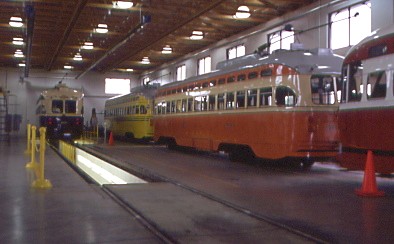
Kenosha Streetcar Line PCC car 4615 2000-present, ex. Vintage Electric Streetcar Company 4615 1996-2000, exx. Toronto Transportation Commission 4615 1991-1996, nee Toronto Transportation Commission 4518 1951-1991 built by St. Louis Car Company in 1951. It is painted in Johnstown Traction livery.
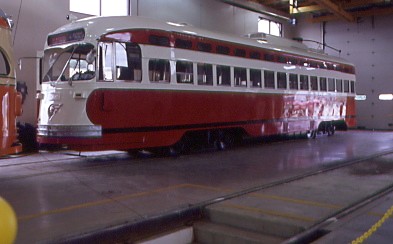
Kenosha Streetcar Line PCC car 4609 2000-present, ex. Vintage Electric Streetcar Company 4609 1996-2000, exx. Toronto Transportation Commission 4609 1990-1996, nee Toronto Transportation Commission 4526 1951-1990 built by St. Louis Car Company in 1951. It is painted in Pittsburgh Railways livery.
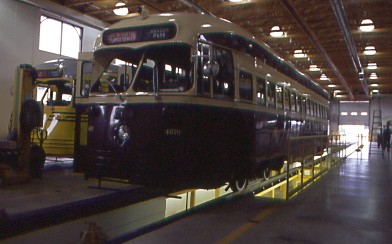
Kenosha Streetcar Line PCC car 4610 2000-present, ex. Vintage Electric Streetcar Company 4610 1996-2000, exx. Toronto Transportation Commission 4610 1990-1996, nee Toronto Transportation Commission 4541 1951-1990 built by St. Louis Car Company in 1951. It is painted in TTC livery.
The shop is very modern and extremely clean as Kenosha Transit takes pride in their operations and it was very kind of them to let me tour their excellent facility; I met mechanic Brad who was extremely helpful.

Now it was time for my ride aboard Kenosha Streetcar Line PCC car 4606 2000-present, ex. Vintage Electric Streetcar Company 4606 1996-2000, exx. Toronto Transportation Commission 4606 1989-1996, nee Toronto Transportation Commission 4528 1951-1989 built by St. Louis Car Company in 1951. It is painted in Chicago Transit Authority livery.
I walked out to the waiting PCC car meeting Carl, the operator of this car. Already aboard were Carol and Tom from the last rare mileage trips I was on in the Pacific Northwest. It certainly is a small world! The streetcar ran a counter-clockwise loop of 1.88 miles and we departed running along the east side of 54th Street for three blocks where we turned left onto 11th Avenue in front of the Metra station. At 56th Street, we turned left and ran down a grassy median lined with trees, passing the County building, court house, Civic Center building and post office before stopping at red signals and pausing at stop signs.
At 3rd Avenue, Southport Marina came into view to the southeast with Lake Michigan beyond. We passed Fountain Plaza to the north with the Kiwanis Clock and Wallace Fountain to the south. Kenosha also has a Harborwalk that was seen and would be in sight the rest of the trip. The PCC next came to the only passing track and we turned left to loop back to the west, passing Celebration Place with two small lighthouses on our side of the channel and a nice large red lighthouse across the channel to Kenosha Harbor. We ran north along 54th Street with views of Kenosha Harbor, the Southport Lighthouse and Keepers Quarters now very much inland, as well as Navy Park. The Holiday Inn Express where I was staying this evening, sat at the north end of Kenosha Harbor.
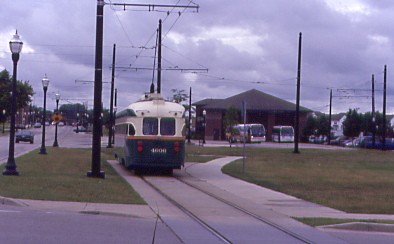
We returned to the Transit Center and I thanked Carl for a great ride.
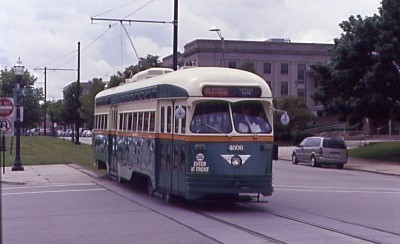
At this point, I needed a new roll of film so as I was doing that, Ron came up with a great idea to have Gary stop the PCC wherever I wanted so once we returned to near the Southport Marina, Gary and I worked as a team, making six photo stops along the way.

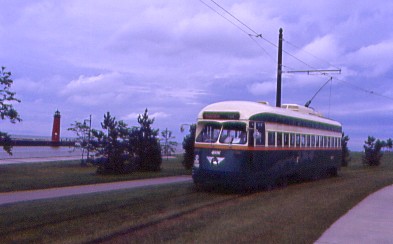
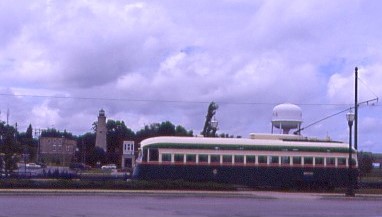
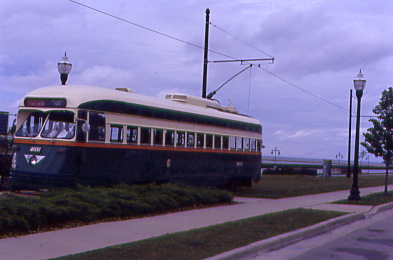
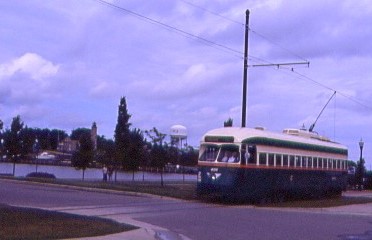
I would like to thank Kenosha Transit for the excellent tour of their streetcar operations. I thanked Gary for the excellent trips and back in the shop, both Ron and Brad. Bob drove me over to the Holiday Inn Express, ending my fantastic tour.
Kenosha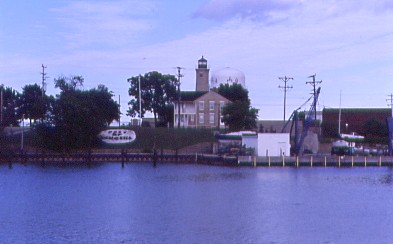
Once I checked in, it was laundry time so I watched MASH and listened to Black Sabbath Live with Ronnie James Dio as the singer. I called Trainweb to check in and later my mother, then walked over to get a roast beef sandwich from Subway.
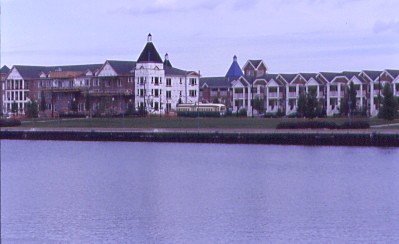
I had a harbourside view and managed to get a picture of the trolley across Kenosha Bay then watched California State Fullerton Titans beat South Carolina 4-0 to advance to the College World Series and called it a night after another enjoyable waterfalls shower and had a good night's sleep.
| RETURN TO THE MAIN PAGE |